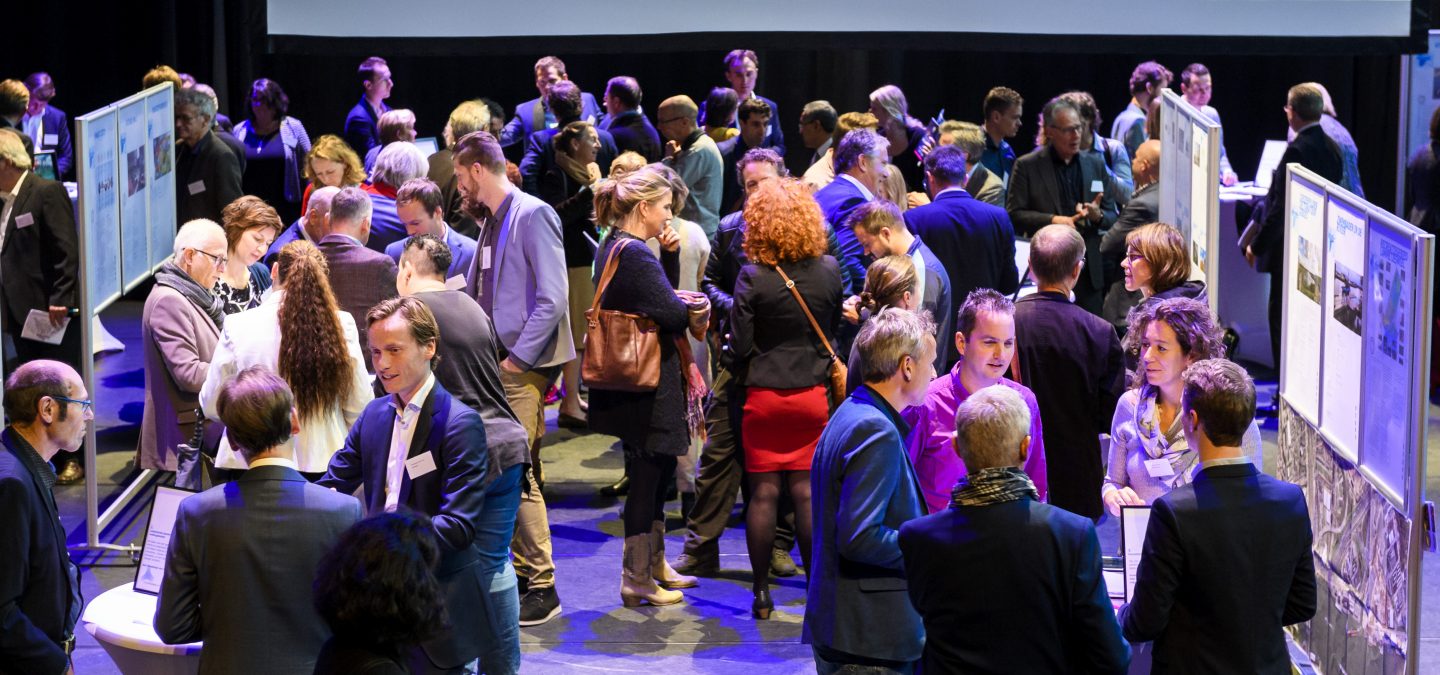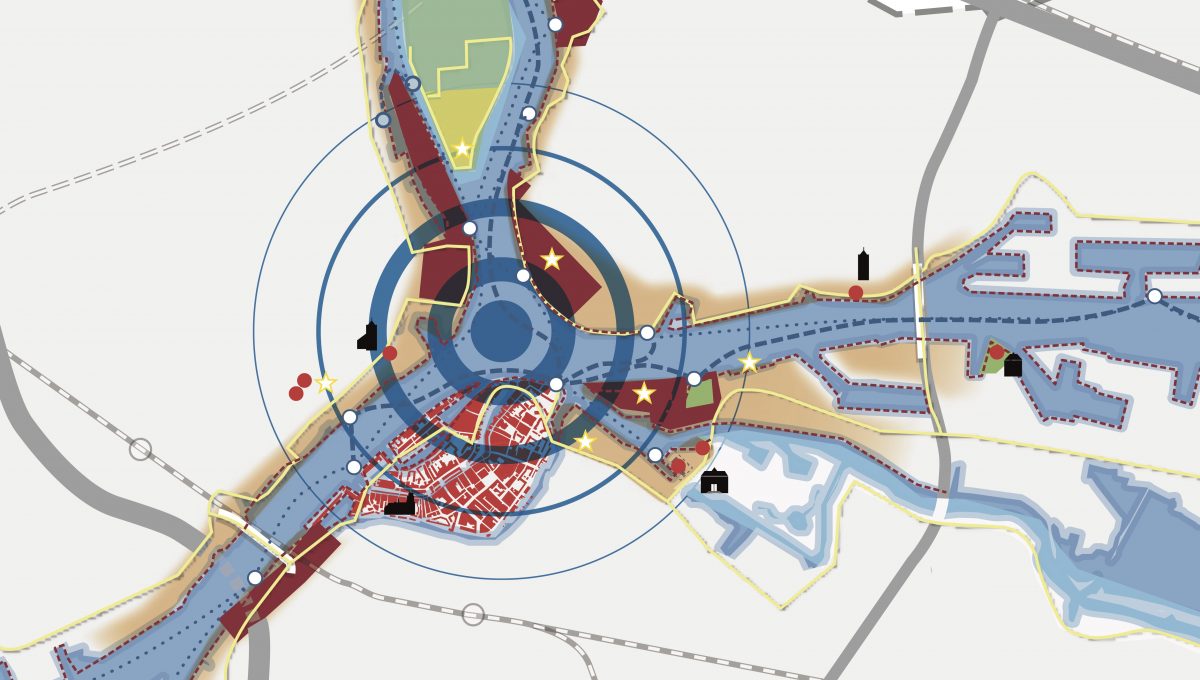
Keep up with our latest news and projects!

Three rivers – the Beneden-Merwede, the Oude Maas and the Noord – converge at a point in South Holland, aptly named Drierivierenpunt, or the Three River Junction. In fact, it’s the busiest river junction in Europe. Three municipalities are located at this junction: Dordrecht, Papendrecht and Zwijndrecht. The individual city maps of these cities stop where the water begins: in other words, the maps don’t show what’s on the other side of the water. Thus each municipality literally doesn’t look beyond its own border, making the water more of a restrictive feature than a connecting one. ‘The Drierivierenpunt is a unique place, and there is now a joint plan to further develop the area and connect locations with each other,’ says Nicole op de Laak, head of Spatial Development Department of the municipality of Papendrecht and chair of the ‘netwerk fysiek’ management team for the Drechtsteden region. ‘Now that we’ve reached that point, the trick is to take the next important steps.’
‘The location on the junction of three rivers makes the Drechtsteden truly unique,’ Nicole says. ‘The area has many qualities: the presence of the water; the near proximity of cultural-historic heritage such as Kinderdijk and the historic centre of Dordrecht; the fact that it is situated next to the Biesbosch national park; the other centres with their own quality of life and housing; the maritime industry; and a good public transport system on the water. There are many options for enhancing the banks of the Drierivierenpunt for the purposes of living, working and recreation. This potential, however, is still untapped. There are several reasons for this. In many areas there is soil contamination, heavy industry and agreements with parties that have development rights. That often complicates the development of projects on the banks. But there are also excellent examples of something special arising. One example is the construction of a hotel-restaurant in a former water tower in Dordrecht. Named ‘Villa Augustus’, it is now a unique gem in the Drierivierenpunt. The Energiehuis, a cultural centre housed in a former power plant, and the movie theatre were added at a later stage. The development of these amenities has substantially enhanced the quality of time people spend on the banks.’
Atelier Drechtsteden’s aim was to develop a joint vision and identify opportunities for the approach to the overall area. Participants were challenged to think about the area’s future from a ‘border-free’ perspective (a perspective that ignores physical and intellectual borders). ‘That worked,’ Nicole says. ‘Existing initiatives and ideas in the region were also identified, and we can build on these to achieve our vision: the so-called “visitekaartjes” (“calling cards”)”. As many as 80 have been itemised. So there’s plenty of energy in this region.’
‘Not entirely,’ Nicole says. ‘I think this can be explained by several reasons. The results of the studio were linked to other visions and were presented to the board collectively. Processing that takes time. In order to get people to accept our recommendation of a “border-free” area, there is a tendency, to split it up again. That’s understandable, but there’s a risk attached to that. If the challenge is split up too early, this will lead to a loss of coherence. It’s important to take another step forward in refining an overarching vision aimed at all of the locations on the banks and agreeing on a cohesive programme. The profile of an individual location is primarily determined by the special qualities and environmental characteristics of that specific place. It is precisely by viewing these places in relation to one another that we can ensure a diverse range of activities on the water and the banks. Subsequently, each municipality can use the results to contribute to the larger whole.’
‘I think that placemaking and a bottom-up approach can help to make the places located on the banks more visible individually, or sometimes perhaps in relation to one another. You have to connect to the location’s uniqueness to the greatest extent possible. That’s the reason why people want to be there, live and recreate there. RiverArt is a good example. Art is being used to connect the banks between Rotterdam and the Drechtsteden with each other. Alternating places with special artworks give special meaning to individual places as well as the larger area.
‘We could improve the way we’re linking up with existing initiatives as well: the 80 calling cards. Such as water bus stops: public spaces that can be made attractive to stay there a while. Or the location of the banks in Alblasserdam, which is an entry point for both Kinderdijk and the Drechtsteden.
‘You can also attract temporary events, such as festivals, to places to give them added value. Or make the banks more accessible so that people will start walking and cycling there. Moreover, by enhancing the green spaces you can make the area more appealing. The Deltametropool Association is conducting a study on the landscape as a condition for settlement. Following the example of the Atelier Drechtsteden, the Drechtsteden region is one of the pilots of this study. There are also techniques for decontaminating the soil by creating green areas, which is a potential way of solving the soil contamination in locations along the banks. Finding momentum and co-financing from other parties are important conditions for the execution of the plans.’
‘Once you agree on the main challenges,’ Jantine Prins, strategic advisor of the municipality of Papendrecht says, ‘then you can accomplish a great deal bottom-up. Indeed, the main challenge should actually be a test. To keep everyone on their toes you can make some kind of an agreement about quality assurance: “We were supposed to go for the best, not the quickest, weren’t we?” You can also link up with the citymakers movement: people who have creative ideas about the area and strengthen the area or have the ability to make the area more visible. Now we need to look for a mixture of strategic and implementation capacities to really start making the next promising steps.’
 ©️ BGSV
©️ BGSV
Interested? Join The City At Eye Level and share your story!
Discover moreCommissioned by the Drechtsteden, G.J. Jansen wrote a report in 2015 about the future of the ‘Drecht’ cities: ‘Zichtbaar Samen Maritiem’ (‘Visible Together Maritime’). Jansen argued that there’s a great deal of untapped potential in the Drechtsteden region and that it’s lagging behind in terms of the quality of life and living, and failing to take advantage of economic opportunities. According to Jansen, municipalities and stakeholders should look at the area from a perspective that ignores the municipal borders and increases the visibility of the overall area. In order to implement this in practice, civil servants from the seven ‘Drechtsteden’ municipalities set up a studio in 2016 called the Atelier Drechtsteden. Supervised by studio manager Jeroen Laven from Stipo, they conducted research to assess opportunities for enhancing the socio-economic position of the Drechtsteden as a leading maritime region. The seven municipalities are Alblasserdam, Dordrecht, Hendrik-Ido- Ambacht, Papendrecht, Sliedrecht, Zwijndrecht and Hardinxveld- Giessendam, which will become part of the Drechtsteden region in the near future.